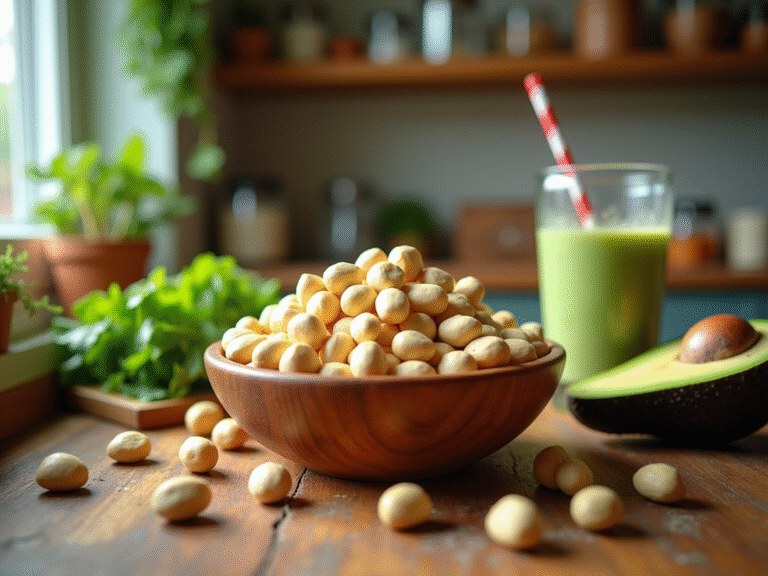10 Foods Rich in Nitric Oxide for Enhanced Health
Overview
Foods rich in nitric oxide, including beets, garlic, leafy greens, and dark chocolate, are essential for enhancing cardiovascular health. These foods improve blood flow and reduce blood pressure, making them vital for overall well-being. They contain dietary nitrates and other compounds that the body converts into nitric oxide. As a result, incorporating these foods into your diet can promote vitality and health.
Furthermore, understanding the benefits of these foods can encourage healthier eating habits. By focusing on what you consume, you can take proactive steps towards better cardiovascular health. Explore further resources to learn more about how to integrate these nutritious options into your meals.
Introduction
In a world increasingly focused on health and wellness, the role of nutrition is paramount. Foods rich in nitric oxide, such as beets, garlic, and dark chocolate, are gaining recognition for their remarkable ability to enhance cardiovascular health and overall vitality. This article explores ten powerful foods that not only elevate nitric oxide levels but also provide a delicious way to improve well-being.
- How can simple dietary choices lead to profound changes in health?
- What culinary delights await those willing to explore this vibrant array of ingredients?
ByKomi: Nutritional Recipes for Nitric Oxide Enhancement
ByKomi.com presents a diverse array of nutritional recipes specifically designed to incorporate foods rich in nitric oxide to enhance levels in the body. These recipes feature ingredients known for their high nitrate content, such as beets and leafy greens, which are examples of foods rich in nitric oxide when combined with other healthful components. For instance, consider a nutritious ribeye steak recipe that includes:
- 2 ribeye steaks, approximately 1 inch thick
- 2 tablespoons of grass-fed butter
- Salt
- Freshly ground black pepper
- 1 tablespoon of olive oil
This dish not only provides essential nutrients but also promotes overall well-being and vitality.
Furthermore, savory beef liver patties, crafted from fresh beef liver and ground beef, are complemented by:
- Finely chopped onions
- Minced garlic
- Breadcrumbs
- An egg
These patties are nutrient-rich and can be customized with various herbs and spices to enhance flavor. By focusing on delicious and nutritious meals, ByKomi empowers individuals to make informed dietary choices that foster healthy aging and enhance well-being.
Recent studies indicate that foods rich in nitric oxide, such as dietary nitrates, can improve cardiovascular health by increasing blood flow and reducing blood pressure. As Hippocrates wisely stated, ‘Let food be your medicine and medicine be your food,’ highlighting the crucial role of nutrition in health. ByKomi’s recipes serve as practical interventions, enabling readers to seamlessly integrate these beneficial foods into their diets, ultimately promoting a healthier, more vibrant life.
Beets: Natural Nitrate Powerhouse for Nitric Oxide
Beets are considered one of the most abundant foods rich in nitric oxide, as they contain dietary nitrates that the body transforms into nitrogen monoxide. This process is crucial as it helps improve blood flow, lowers blood pressure, and enhances exercise performance. But how can you incorporate beets into your diet? Consuming beets can be as simple as adding roasted beets to salads or drinking beet juice.
Research has demonstrated that beetroot supplementation is one of the foods rich in nitric oxide that can significantly elevate nitrogen compound levels. As a result, incorporating foods rich in nitric oxide becomes a vital inclusion in any diet aimed at improving cardiovascular health. By making beets a regular part of your meals, you can take proactive steps towards better heart health. Explore further resources to learn more about the benefits of dietary nitrates and how they can enhance your wellness.
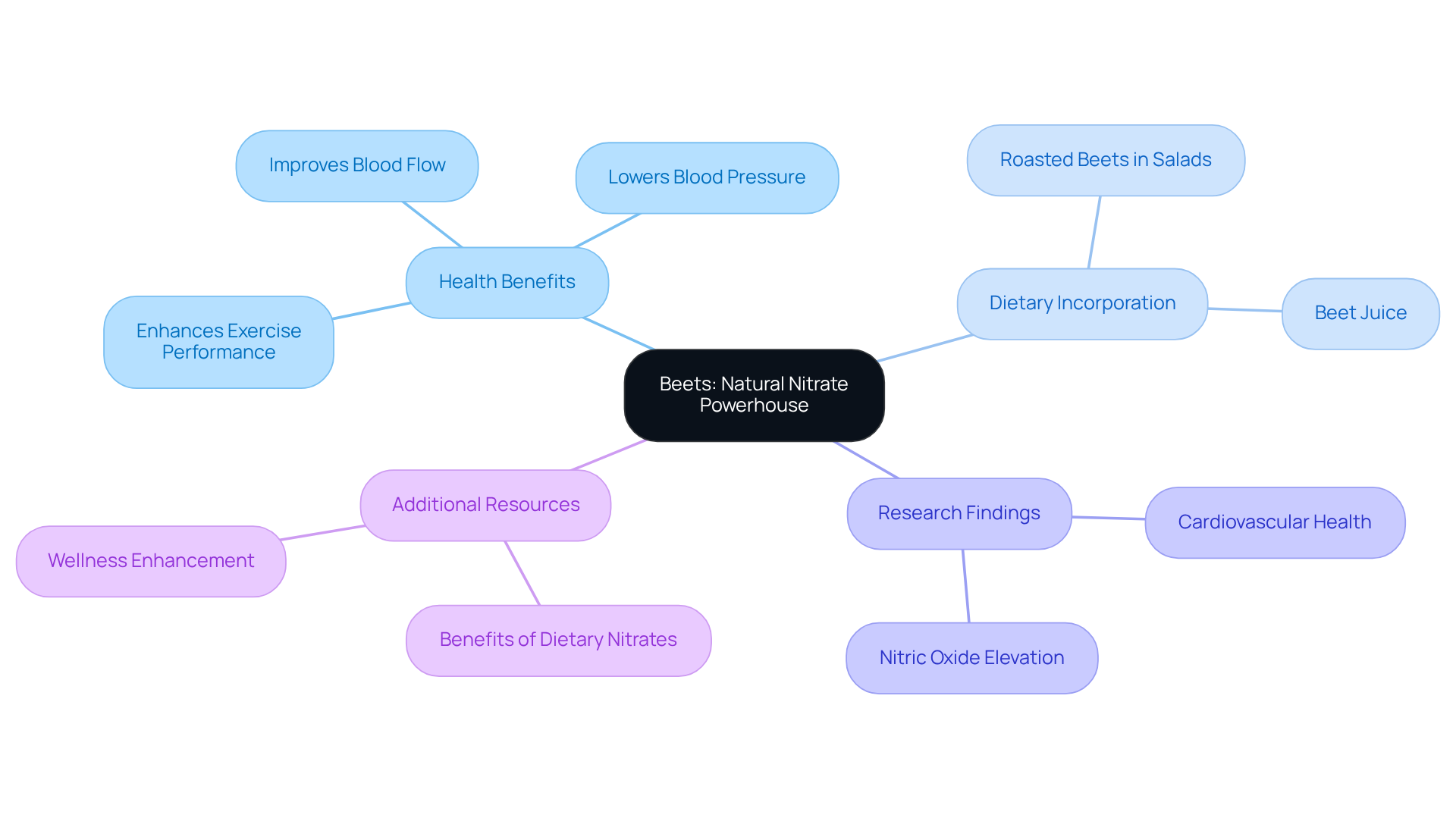
Garlic: A Flavorful Booster of Nitric Oxide Levels
Garlic is renowned for its extraordinary ability to enhance nitrogen compounds in the body. This powerful bulb contains bioactive substances that stimulate the enzyme essential for converting the amino acid L-arginine into nitrogen gas. Frequent consumption of garlic has been linked to notable improvements in cardiovascular health, including reductions in systolic pressure by approximately 8-12 mmHg and diastolic pressure by around 5-10 mmHg. These benefits make garlic one of the essential foods rich in nitric oxide, making it a valuable addition to any diet aimed at boosting nitric oxide levels.
Furthermore, garlic’s antioxidant properties contribute to its heart-protective effects, helping to mitigate oxidative stress and inflammation. As wellness expert Priyom Bose states, “Garlic’s antioxidant and nitrogen oxide enhancing effects may assist in reducing blood pressure.” In addition, incorporating Trimethylglycine (TMG) into your diet can further support cardiovascular health, as TMG plays a vital role in methylation processes.
Adding garlic to various dishes not only enhances flavor but also offers significant health benefits, highlighting its role as one of the foods rich in nitric oxide that can elevate nitric oxide levels in a diet. However, it is essential to recognize that some individuals may experience a garlic allergy.
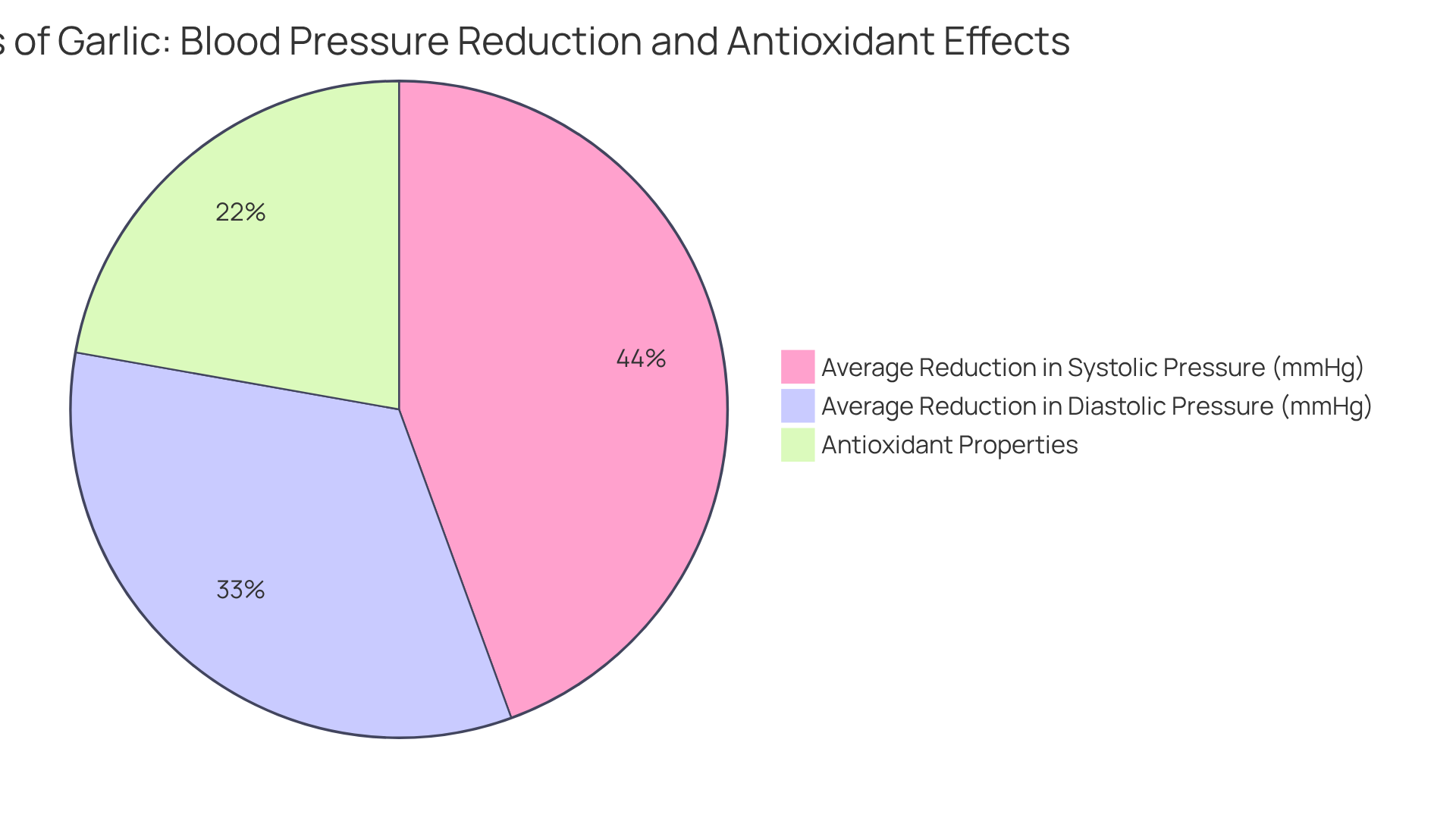
Meat: Nutrient-Dense Source for Nitric Oxide Support
Red meat, particularly beef and lamb, serves as a robust source of L-arginine, an amino acid vital for the production of nitrogen gas. This amino acid plays a crucial role in heart health, as nitrogen monoxide helps expand blood vessels, thereby enhancing circulation and overall vitality. Research indicates that foods rich in nitric oxide, particularly those containing high-quality animal proteins, significantly boost nitrogen gas production. Moreover, organ meats, such as liver, are nutrient-dense foods rich in nitric oxide, which makes them essential components of a health-conscious diet. By incorporating these nutrient-rich foods, you can promote not only cardiovascular function but also overall well-being.
To reap the benefits of L-arginine while supporting your health, consider preparing ribeye steaks using the following method:
- Remove the ribeye steaks from the refrigerator about 30 minutes before cooking to allow them to reach room temperature.
- Pat them dry with paper towels and season generously with salt and pepper on both sides.
- Heat olive oil over high heat in a large cast-iron skillet until it shimmers.
- Carefully place the steaks in the hot skillet and sear without moving them for approximately 4-5 minutes until a golden brown crust forms.
- Flip the steaks, add grass-fed butter, and baste with the melted butter as they cook for an additional 4-5 minutes for medium-rare doneness.
- Let the steaks rest for at least 5 minutes before slicing to ensure juiciness.
- Serve warm, drizzled with the melted butter from the pan.
However, individuals should be mindful of potential interactions; for example, L-arginine can lower sugar levels, which may pose risks for those on diabetes medications. Additionally, consider integrating beef liver patties into your meals for an extra nutrient boost.
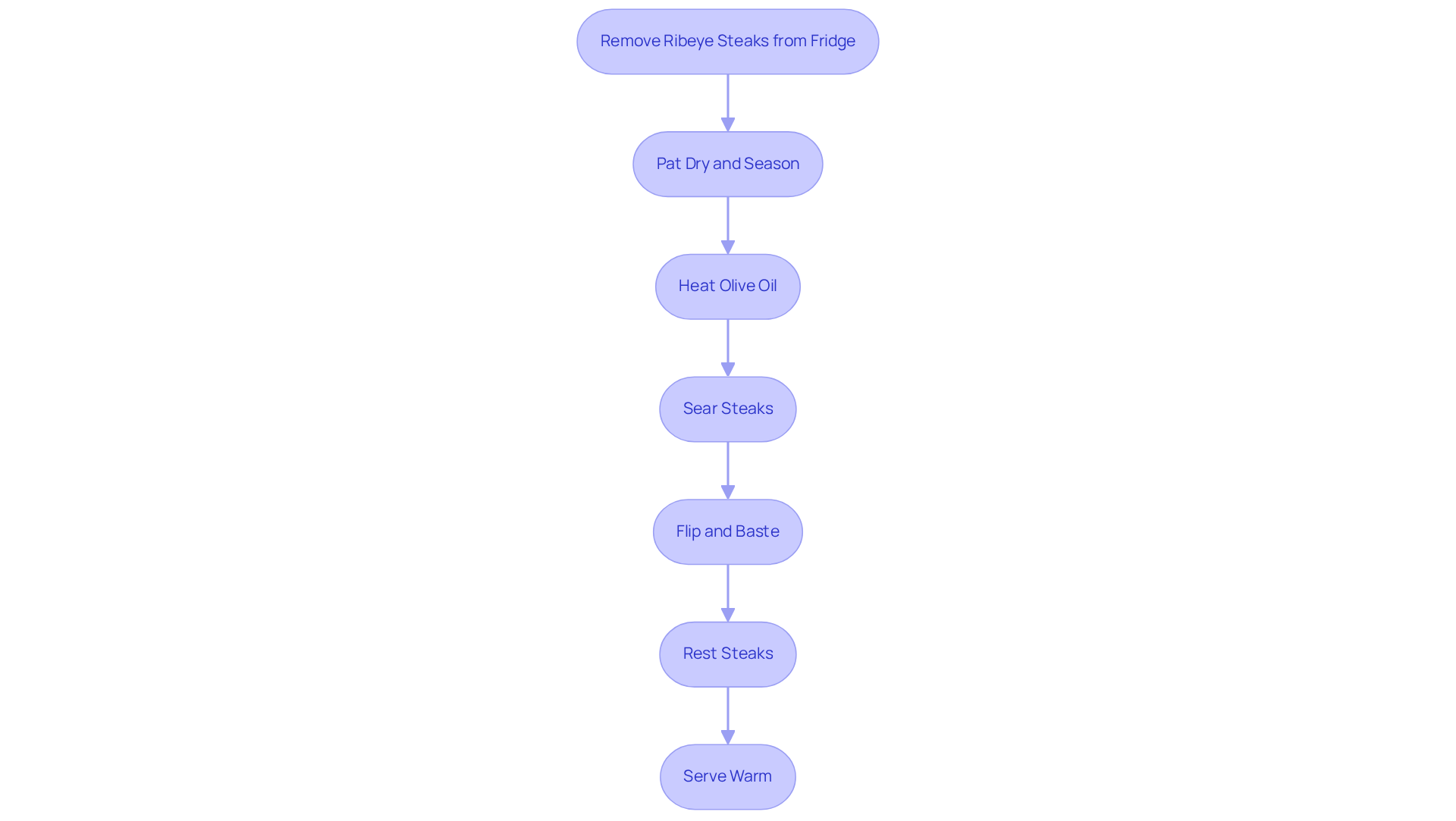
Dark Chocolate: A Tasty Way to Boost Nitric Oxide
Dark chocolate, particularly varieties with at least 70% cocoa, is considered one of the foods rich in nitric oxide, serving as a powerhouse of flavanols that significantly stimulate nitric oxide production in the body. This process is crucial for enhancing circulation, reducing arterial pressure, and improving overall cardiovascular well-being. Recent studies have shown that regular intake of dark chocolate can lead to notable enhancements in cardiovascular metrics. For example, dietary changes can lower systolic pressure by up to 11 mmHg in hypertensive individuals.
Furthermore, dark chocolate’s low glycemic index aids in blood sugar regulation, making it an effective option for managing diabetes and weight issues. To fully enjoy these health benefits, it’s advisable to consume dark chocolate in moderation—ideally around 20-30 grams daily, as this amount has been commonly used in studies to observe health improvements. Additionally, indulging in 85% dark chocolate may positively influence mood, transforming it into a delightful treat that elevates your levels of foods rich in nitric oxide while also satisfying your sweet cravings.
Including potassium-rich foods in your diet is also essential for regulating blood pressure, thus enhancing the advantages of dark chocolate. By incorporating these elements into your daily routine, you can take significant steps toward better health.
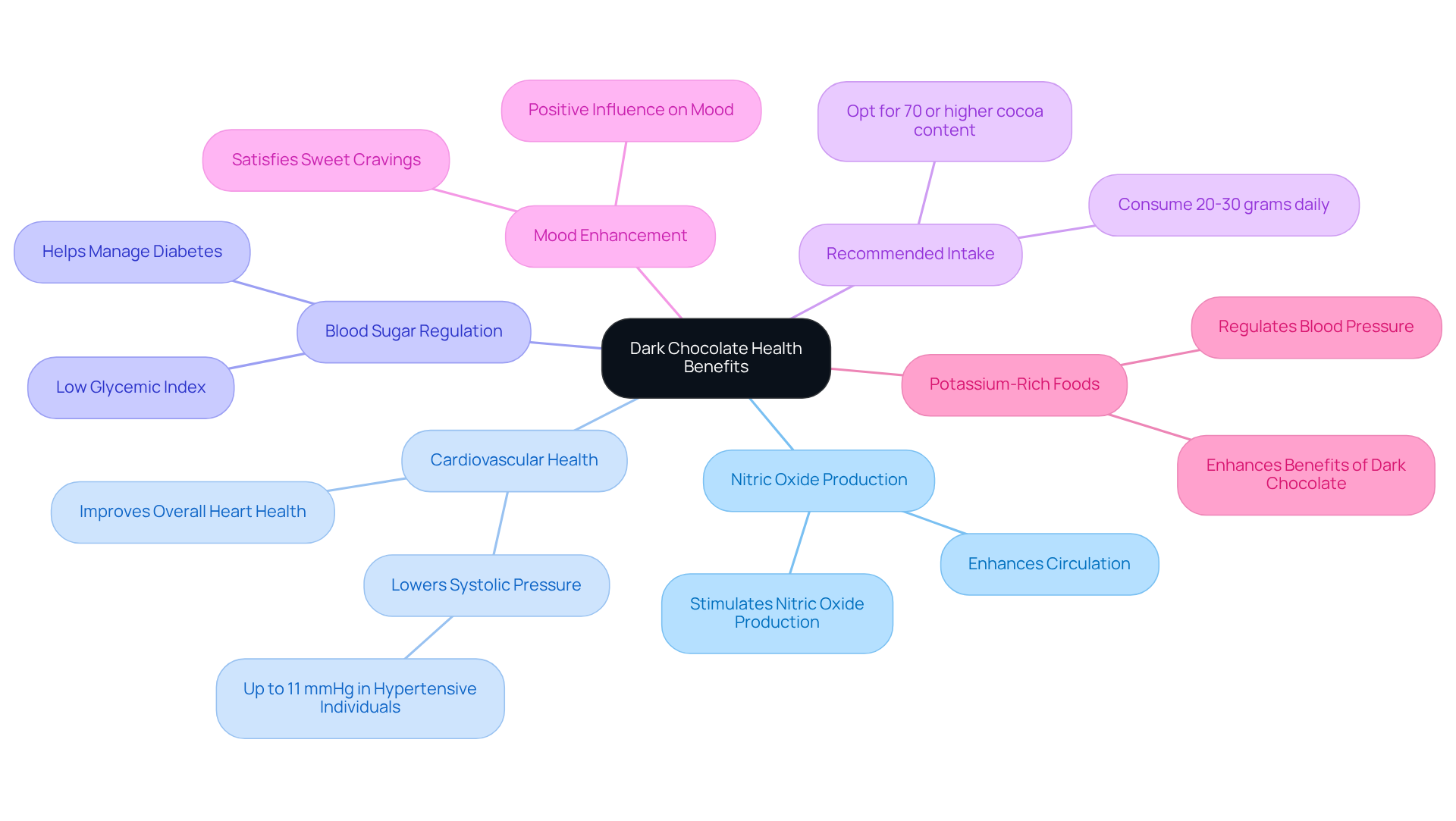
Leafy Greens: Essential for Nitric Oxide Production
Leafy vegetables, including spinach, kale, and arugula, are considered foods rich in nitric oxide because they contain nitrates that the body converts into this essential compound for cardiovascular health. Regular consumption of foods rich in nitric oxide, such as these vegetables, is linked to significant health benefits, including:
- Improved circulation
- Reduced blood pressure
- A lower risk of heart disease
All are crucial for healthy aging. Research shows that individuals who eat foods rich in nitric oxide, such as one cup of nitrate-rich vegetables daily, can lower their systolic blood pressure by about 2.5 mmHg and decrease their risk of cardiovascular diseases by 12 to 26%. To fully reap these benefits, consider adding a variety of leafy greens to your meals—whether in salads, smoothies, or as side dishes. A diverse selection ensures a rich intake of vital nutrients that promote healthy aging and vitality.
As registered dietitian Cara Rosenbloom notes, “Nitric gas plays many important roles in your body. It promotes cardiovascular well-being, assists your muscles in functioning, and aids normal breathing.”
ByKomi.com serves as your comprehensive resource for understanding how such dietary choices can contribute to innovative therapies and strategies for healthy longevity. For further insights, consider exploring dietary practices inspired by the Hunza people, who prioritize a balanced intake of nutrient-rich foods, including leafy greens, as part of their longevity-promoting lifestyle.
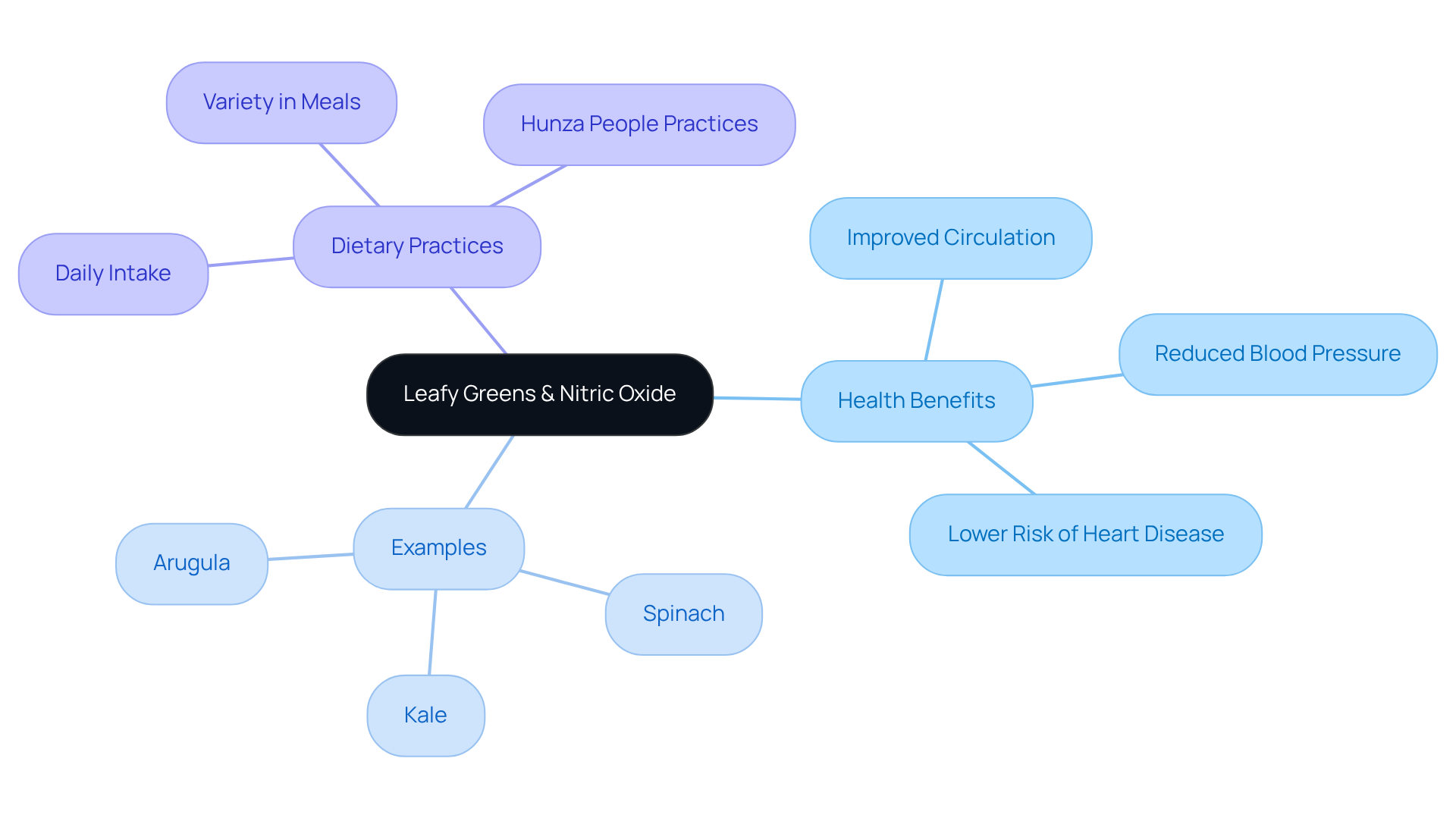
Citrus Fruits: Refreshing Sources of Nitric Oxide Boost
Citrus fruits, including oranges, lemons, and grapefruits, are rich in vitamin C, a vital nutrient for stabilizing and absorbing nitrogen compounds in the body. By consuming citrus fruits, which are among the foods rich in nitric oxide, you can boost nitrogen compound activity, enhance circulation, and promote cardiovascular health.
Incorporating these fruits into your diet is straightforward; consider adding them to:
- Smoothies
- Salads
- Enjoying them as snacks
Their refreshing flavor, combined with their health benefits, makes citrus fruits some of the best foods rich in nitric oxide that can be added to any diet aimed at increasing oxide levels.

Pomegranates: Antioxidant-Rich Boosters of Nitric Oxide
Pomegranates serve as a rich source of antioxidants, particularly polyphenols, crucial for protecting nitrogen compounds from oxidative damage. This protective effect not only enhances the biological actions of nitric oxide but also promotes better circulation and cardiovascular health, which can be supported by consuming foods rich in nitric oxide. Studies indicate that regular consumption of pomegranate juice can lead to significant health benefits, including a 32% reduction in inflammatory markers after daily intake, which is particularly beneficial for those engaged in physical activities.
Furthermore, research has demonstrated that pomegranate juice aids muscle recovery and athletic performance by improving blood flow and oxygen delivery to muscles. This results in delayed fatigue and enhanced performance. Additionally, pomegranates possess antimicrobial properties that help combat oral bacteria, further contributing to overall health.
Incorporating pomegranate juice or seeds into your diet is an enjoyable way to naturally boost your nitrogen levels with foods rich in nitric oxide while reaping its many antioxidant benefits. Whether added to salads, blended into smoothies, or enjoyed as a refreshing snack, pomegranates offer a delicious approach to enhancing cardiovascular wellness and cognitive function.
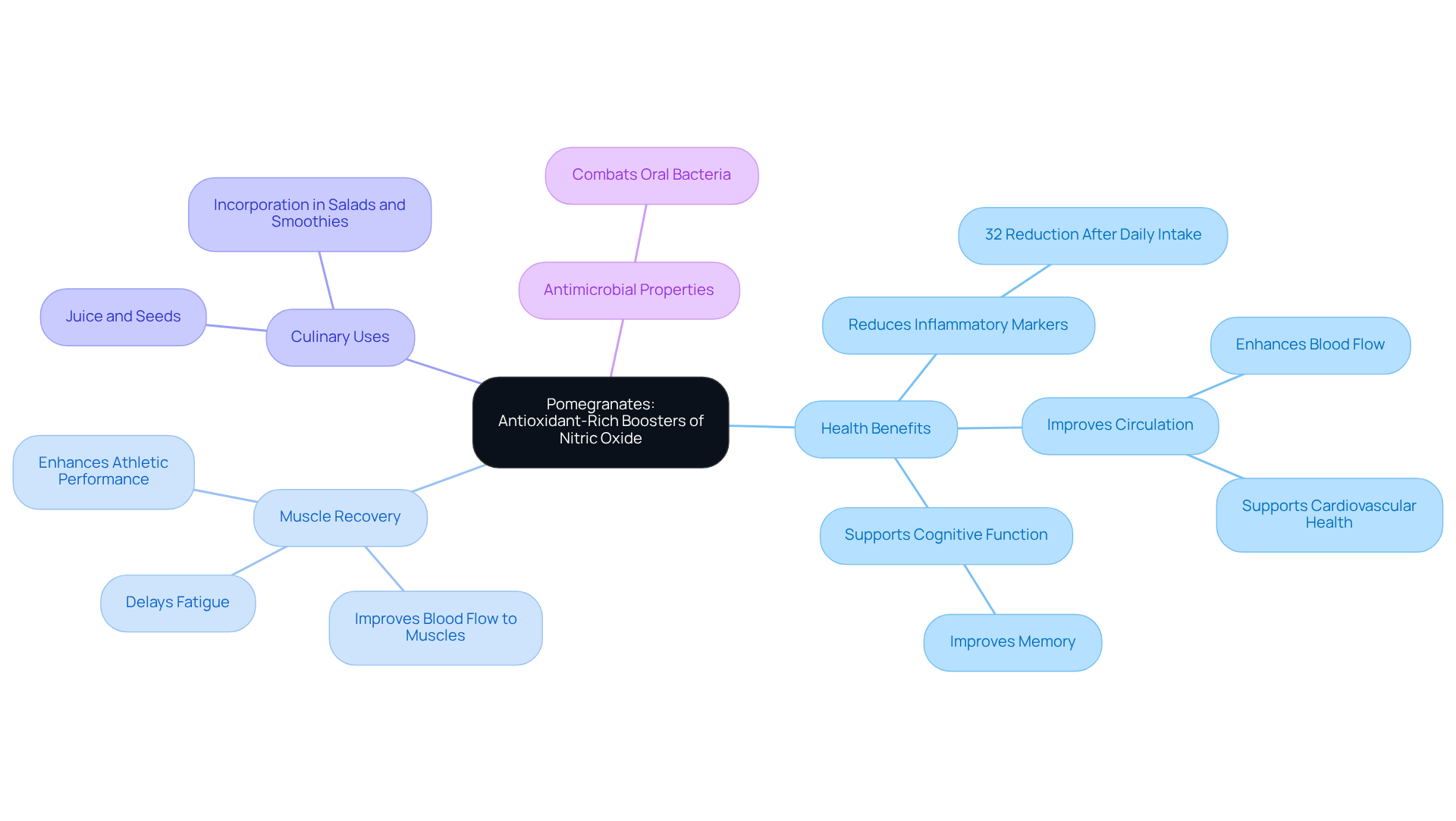
Nuts and Seeds: Nutrient-Rich Snacks for Nitric Oxide
Nuts and seeds, including almonds, walnuts, and sunflower seeds, are considered foods rich in nitric oxide due to their excellent content of L-arginine, an essential amino acid crucial for nitric oxide production. Regular consumption of foods rich in nitric oxide, along with other nutrient-rich snacks, can significantly enhance circulation, lower vascular pressure, and promote cardiovascular health. Studies reveal that adding foods rich in nitric oxide to your diet, such as those high in arginine, can result in measurable improvements in cardiovascular function within just two weeks. Furthermore, consuming foods rich in nitric oxide can lead to increased nitrogen levels, resulting in reduced blood pressure, improved exercise performance, and enhanced brain function, making these snacks even more beneficial.
These versatile snacks can be enjoyed on their own, sprinkled on salads, or blended into smoothies, providing a simple way to elevate your nutrient intake. To fully harness their health benefits, aim to include a variety of nuts and seeds in your daily meals. This practice is vital for enhancing blood compounds and preventing issues such as heart disease and diabetes through the consumption of foods rich in nitric oxide.
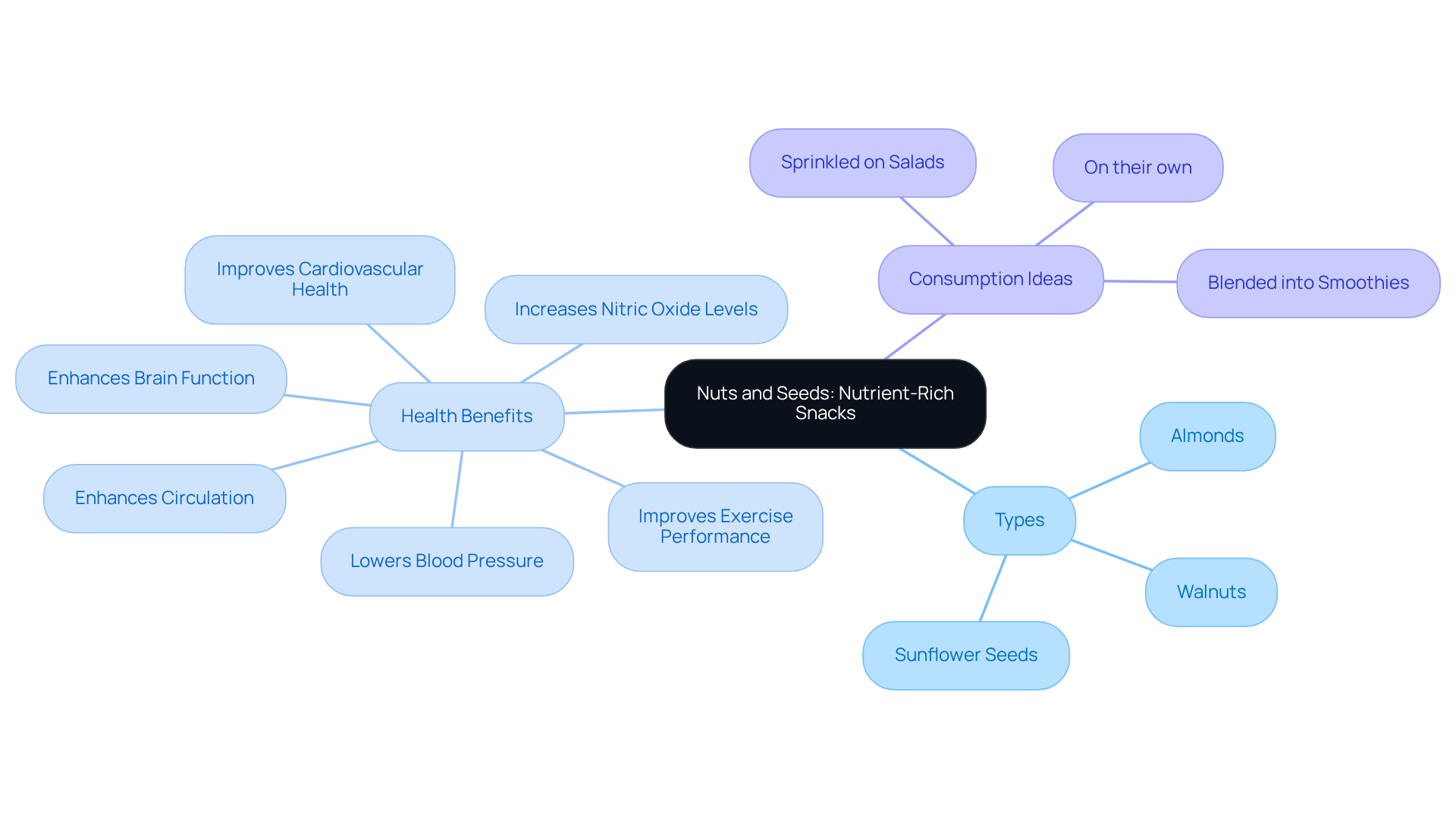
Watermelon: Hydrating Source of Nitric Oxide Boost
Watermelon serves as a key source of citrulline, an amino acid that the body effectively converts into arginine, which is subsequently transformed into nitrogen monoxide. This biochemical process is essential for improving blood flow, lowering blood pressure, and enhancing exercise performance. Research indicates that consuming foods rich in nitric oxide, such as watermelon, can significantly elevate nitric oxide levels.
Furthermore, watermelon is rich in nutrients like vitamin C, lycopene, and potassium, all of which contribute to overall well-being. Interestingly, the entire watermelon, including the rind, is edible and contains high levels of citrulline, making it an ideal choice for a refreshing snack or a nutritious addition to smoothies.
Incorporating watermelon into your diet can thus play a vital role in promoting health and vitality, while also potentially alleviating muscle soreness and encouraging blood flow. Why not explore the benefits of this delicious fruit today?

Conclusion
Incorporating foods rich in nitric oxide into daily diets represents a powerful approach to enhancing overall health and well-being. The benefits of these foods extend beyond mere nutrition; they play a crucial role in improving cardiovascular health, boosting exercise performance, and promoting healthy aging. By focusing on diverse ingredients such as beets, garlic, leafy greens, and dark chocolate, individuals can make informed dietary choices that foster vitality and longevity.
Throughout this article, key foods have been highlighted for their exceptional ability to elevate nitric oxide levels. Beets and leafy greens serve as nitrate powerhouses, while garlic and dark chocolate contribute unique compounds that enhance nitric oxide production. Furthermore, nutrient-dense options like red meat, nuts, and watermelon not only support nitric oxide synthesis but also provide essential nutrients for optimal health. Integrating these foods into meals can lead to significant improvements in blood flow, blood pressure regulation, and overall cardiovascular function.
Ultimately, the significance of embracing a diet rich in nitric oxide cannot be overstated. It empowers individuals to take control of their health through delicious and nutritious choices. By prioritizing these foods, one can pave the way for a healthier lifestyle, improved well-being, and a greater quality of life. Embrace the journey of culinary exploration and discover the myriad ways to enhance nitric oxide levels for a vibrant, thriving existence.
Frequently Asked Questions
What is the purpose of ByKomi’s nutritional recipes?
ByKomi’s nutritional recipes are designed to incorporate foods rich in nitric oxide to enhance levels in the body, promoting overall well-being and vitality.
What are some key ingredients in ByKomi’s recipes?
Key ingredients include foods high in nitrates, such as beets, leafy greens, ribeye steak, and beef liver, which can be combined with other healthful components.
Can you provide an example of a recipe from ByKomi?
An example is a ribeye steak recipe that includes 2 ribeye steaks, 2 tablespoons of grass-fed butter, salt, freshly ground black pepper, and 1 tablespoon of olive oil.
What are the health benefits of consuming beets?
Beets are rich in dietary nitrates, which the body converts into nitrogen monoxide, improving blood flow, lowering blood pressure, and enhancing exercise performance.
How can beets be easily incorporated into a diet?
Beets can be added to salads, consumed as roasted beets, or enjoyed as beet juice.
What role does garlic play in enhancing nitric oxide levels?
Garlic contains bioactive substances that stimulate the enzyme needed to convert L-arginine into nitrogen gas, which helps improve cardiovascular health and reduce blood pressure.
What are the cardiovascular benefits of consuming garlic?
Frequent consumption of garlic can lead to reductions in systolic pressure by approximately 8-12 mmHg and diastolic pressure by around 5-10 mmHg.
Are there any precautions to consider when consuming garlic?
Some individuals may experience a garlic allergy, so it is important to recognize this potential issue.
How does ByKomi encourage healthy dietary choices?
ByKomi empowers individuals to make informed dietary choices by providing delicious and nutritious meal options that include foods rich in nitric oxide.
What is the significance of dietary nitrates according to recent studies?
Recent studies indicate that dietary nitrates can improve cardiovascular health by increasing blood flow and reducing blood pressure.






